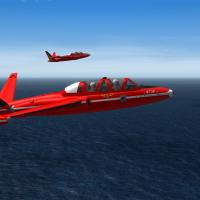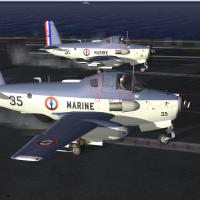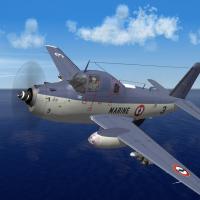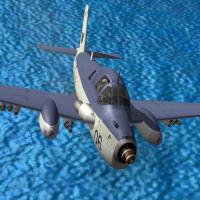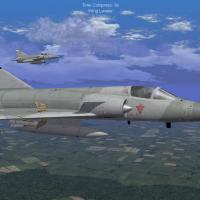
Swiss Mirage III Pack
Install - Need Update July 2012, DLC Mirage IIIO
In 1961, Switzerland bought a single Mirage IIIC from France. This Mirage IIIC was used as development aircraft. The Swiss Mirages were built in Switzerland by F+W Emmen (today RUAG ) (the federal government aircraft factory in Emmen) as the Mirage IIIS. Australia too, bought, one French-made in preparation for licensed production. Cost overruns during the Swiss production led to the so-called "Mirage affair". In all, 36 Mirage IIIS interceptors were built with strengthened wings, airframe, and undercarriage. The Swiss Air Force required performance comparable to those of carrier based planes; the airframes were reinforced so the aircraft could be moved by lifting them over other aircraft with a crane, as in the Aircraft cavern in the mountains that Swiss Air Force uses as bunkers, offer very little space to maneuver parked aircraft. Also, the strengthened frames allowed for JATO assisted takeoffs. The main differences to the standard Mirage III were as follows:
New wiring of avionics with U.S. electronics
Changed cockpit design with gray instead of black panels
New U.S. radar, TARAN-18 from Hughes
Use of HM-55S "Falcon" (Swiss designation of the from SAAB in Licence built Robot 27 (Rb27) which is similar to the Hughes AIM-26 "Falcon")
Radar warning receiver (RWR) on both wingtips and on the back of the rudder
Strengthened structure for use of JATO-Rockets
Retractable nosecone and lengthened nosewhlle leg for storing in underground air base
Four lifting points for moving aircraft in underground caverns with a crane
Bay at the fin with a SEPR rocket engine to double the velocity for short time or climb to 20 000 m (60 000 ft)
US TRACOR AN/ALE-40 chaff/flare dispenser at the back under the end of the engine (fitted with the upgrade 1988)
Canards designed and produced by RUAG Aerospace(fitted with the upgrade 1988)
New Martin-Baker ejection-seat (fitted with the upgrade 1988)
The Swiss Mirages are equipped with RWS, chaff & flare dispensers. Avionics differed as well, with the most prominent difference being that the Thomson-CSF Cyrano II radar was replaced by Hughes TARAN-18 system, giving the Mirage IIIS compatibility with the Hughes AIM-4 Falcon AAM. Also the Mirage IIIS had the wiring to carry a Swiss-built nuclear bomb or French nuclear bomb. The Swiss nuclear bomb was stopped in the preproduction stage and Switzerland did not purchase the French-made bomb. The Mirage IIIS had an integral fuel tank under the aft belly; this fuel tank could be removed and replaced with an adapter of the same shape. This adapter housed a SEPR rocket engine with its liquid fuel tanks. With the SEPR rocket, the Mirage IIIS easily reached altitudes of 20,000 m. The rocket fuel was very hazardous and highly toxic, so the SEPR rocket was not used very often. The Mirage IIIRS could also carry a photo-reconnaissance centerline pod and an integral fuel tank under the aft belly; this carried a smaller fuel load but allowed a back looking film camera to be added. In the early 1990s, the 30 surviving Swiss Mirage IIIS interceptors were put through an upgrade program, which included fitting them with fixed canards and updated avionics. The Mirage IIIS were phased out of service in 1999. The remaining Mirage IIIRS, BS and DS were taken out of
Special thanks to Paulopanz and Coupi.
Mirage IIIBS
Mirage IIIS (Early)
Mirage IIIS
Mirage IIIDS
Mirage IIIRS (Early)
Mirage IIIRS
Modelo - TK (Mirage IIIO)
Texture - Ludo, Denis Oliveira
mod - Denis Oliveira
Decals - Paulopanz
Data.ini - Denis Oliveira, Coupi
Cockpit and Avioncs ini - Coupi, Denis Oliveira
Mirage IIIBL Libanon.
Requirements: DLC Mirage IIIEL
https://store.thirdwire.com/store_dlc.htm
credits:
paulopanz
Coupi
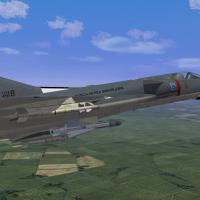
F-103 Mirage III Brazilian Air Force
Install - Need Update July 2012, DLC Mirage IIIO (DLC Mirage IIIEL optional cockpit)
History
The history of the Mirage III in Brazil goes back to the sixties, when the FAB elaborated a modernization program and the creation of an air space control system. In 1967 the implementation started of the SISDACTA- Sistema Integrado de Defesa Aérea e Controle de Tráfego Aéreo (Integrated Air Traffic Control and Air Defence System) and of the COMDA-Comando de Defesa Aérea (Air Defence Command).
As part of the program, it was necessary to acquire a supersonic aircraft to execute the air defence and interception missions. The FAB's initial desire was to obtain the McDonnell Douglas F-4 Phantom II, however it could not be materialised because of American restrictions on the sale of advanced military equipment to South American countries.
With the Phantom out of the game, the remaining option was to look for an European fighter. Among the contenders were the British English Electric Lightning, the Swedish Saab Draken and the French Dassault-Breguet Mirage IIIE. About the same time, the Mirage IIIC, in the hands of the Israeli pilots, inflicted heavy losses to its Arabic neighbours in the 'Six Day War'. There is no doubt that the Mirage III's excellent performance, achieved by the Israelis in that war, helped Dassault-Breguet secure many clients around the world, including Brazil.
Operational Career
On April 11, 1979, the 1º GDA ( Primeiro Grupo de Defesa Aérea – First Air Defence Group) was officially established. On April 19, 1979, the 1º ALADA was disbanded and the 1º GDA took over its functions and F-103 aircraft. The 1º GDA remained stationed at Anápolis AB.
During its operational career in Brazil, the Mirage III fleet suffered some attrition and many additional airframes were bought to replace the lost ones and to keep up the 1º GDA's combat readiness. In total, Brazil acquired 16 additional aircraft from Armée de L’Air surplus. These consisted of four F-103E in 1980, two F-103D in 1984, two F-103E in 1988, two F-103D and two F-103E in 1989, two F-103E in 1998 and the last two F-103D in 1999.
The F-103 Mirage IIIEBR represented a tremendous leap to the Brazilian Air Force, being over thirty years of service and more than 65,000 flying hours.
The versions of Mirage III acquired by FAB were developed primarily for air defense missions, but keep some capacity to act as platforms for ground attack.
The engine was a SNECMA ATAR 09C, whose maximum thrust with afterburning reached 13,900 pounds (6305 kg), leading the aircraft a maximum speed of Mach 2.2 (2,350 km / h).
The fire control system was based on radar Thomson-CSF Cyrano II, which originally operated the integrated air-to-air missile infrared Matra R530, later replaced by Israeli missile Python III.
As arms fixed, the aircraft was equipped with two 30 mm DEFA. For navigation, the Mirage III FAB type Doppler systems used. In the early '90s, the FAB joined the Squadron's missions Jaguar air-ground attack, starting to use free-fall bombs and rocket launchers.
(Portuguese)
História
A história do Mirage III no Brasil remonta à década de sessenta, quando a FAB elaborou um programa de modernização e criação de um sistema de controle do espaço aéreo. Em 1967, a implementação começou da SISDACTA- Sistema Integrado de Defesa Aérea e Controle de Tráfego Aéreo (Air Traffic Control Integrado e Air Sistema de Defesa) e do COMDA-Comando de Defesa Aérea (Comando de Defesa Aérea).
Como parte do programa, foi necessário adquirir um avião supersônico para executar as missões de defesa aérea e interceptação. Desejo inicial da FAB foi obter a McDonnell Douglas F-4 Phantom II, no entanto, ele não poderia ser materializado por causa das restrições americanas sobre a venda de equipamento militar avançado para os países da América do Sul.
Com o Fantasma fora do jogo, a opção restante era procurar um lutador europeu. Entre os contendores foram o Inglês Britânico elétrico do relâmpago, a sueca Saab Draken e os franceses Dassault-Breguet Mirage IIIE. Quase ao mesmo tempo, o Mirage IIIC, nas mãos dos pilotos israelenses, infligiu pesadas perdas para os seus vizinhos árabes na 'Guerra dos Seis Dias ". Não há dúvida de que o excelente desempenho do Mirage III, alcançada pelos israelenses em que a guerra, ajudou a Dassault-Breguet garantir muitos clientes ao redor do mundo, incluindo o Brasil.
Carreira Operacional
Em 11 de abril de 1979, o 1º GDA (Primeiro Grupo de Defesa Aérea - First Air Grupo de Defesa) foi criada oficialmente. Em 19 de abril de 1979 a 1º ALADA foi dissolvida e o 1º GDA assumiu suas funções e aeronaves F-103. O 1º GDA permaneceu estacionada em Anápolis AB.
Durante a sua carreira operacional no Brasil, a frota de Mirage III sofrido algum desgaste e muitas fuselagens adicionais foram comprados para substituir os perdidos e para manter a prontidão de combate do 1º GDA. No total, o Brasil adquiriu 16 aeronaves adicionais a partir do excedente Armée de L'Air. Estes consistiram de quatro F-103E, em 1980, dois F-103D em 1984, dois F-103E, em 1988, dois F-103D e dois F-103E, em 1989, dois F-103E em 1998 e os dois últimos F-103D em de 1999.
O F-103 Mirage IIIEBR representou um tremendo salto para a Força Aérea Brasileira, ficando mais de trinta anos de serviço e voando mais de 65.000 horas.
Os Mirage III das versões adquiridas pela FAB foram desenvolvidas primariamente para missões de defesa aérea, embora mantivessem alguma capacidade de atuar como plataformas de ataque ao solo.
O motor era um SNECMA ATAR 09C, cujo empuxo máximo com pós-combustão alcançava 13.900 libras (6.305 kg), levando a aeronave a velocidade máxima de Mach 2,2 (2.350 km/h).
O sistema de controle de fogo era baseado no radar Thomson-CSF Cyrano II, que originalmente operava integrado ao míssil ar-ar infra-vermelho Matra R530, depois substituído pelo míssil israelense Python III.
Como armamento fixo, a aeronave era dotada de dois canhões DEFA de 30 mm. Para navegação, os Mirage III da FAB utilizavam sistemas tipo Doppler. No inícios dos anos 90, a FAB incorporou ao Esquadrão Jaguar as missões de ataque ar-solo, passando a utilizar bombas de queda livre e lançadores de foguetes.
Special thanks to Paulopanz and Coupi.
Mirage IIIEBR (3 textures and 1 silver texture)
Mirage IIIEBR (fictitious - fuel probe test in 1990-93)
Mirage IIIDRB (late and Early)
Modelo - TK (Mirage IIIO)
Texture - Ludo, Denis Oliveira
mod - Denis Oliveira
Decals - Paulopanz
Data.ini - Denis Oliveira, Coupi
The Belgian Air Force operated 50 Magisters as primary trainers.
The aerobatic team The Red Devils also used them as display aircraft.
A small number of Magisters remained in use until September 2007,
as flight maintenance aircraft for senior officers.
The Belgian Air Force was the last country that used Magisters for full duty.
What's in:
- A new plane;
- 3 skins (1 Silver and 2 Rode Duivels Acro with different underwings);
- Historical decalsets;
- Open canopy 10 key auto closing at take off;
- Weapons
- "real" sound;
- Screens;
- Loadout.tga;
Credits
- Veltro2K - plane model;
- Stary - Pit
- Baffmeister - Final Data.ini and proper FM;
- Paulopanz -Templates, Rode Duivels skins, decals;
- Coupi - Silver Skin and testings;
- Spillone104 - sound;
Install:
- all mod folder content in your mod install
- overwrite
That's all
Enjoy
@ paulopanz
Br.1050_Alize_Early_v1.0
The Breguet Br.1050 Alizé (French: "Tradewind") was a French carrier-based anti-submarine warfare aircraft. It was developed in the 1950s, based loosely on the second prototype Breguet Vultur attack aircraft which had been modified into the Breguet Br.965 Épaulard anti-submarine warfare aircraft.
Made with the collaboration of some great people............
Credits:
Veltro2K :3D model + initial INI's files work
Eole: Project coordinator and other Work:
FOXMONTER :Cockpit
BaffMeister:FMs Beta 0.90
JonathanRL:Weapon stations edit
Torno: Pilots
PauloPanz:Decals.ini work
Nyghtfall: Decals, decals tunning
RavenClaw_007: Rocket lanchers
And all who created the other weapons others weapons
THIS MODEL IS ONLY TO BE DISTRIBUTED AS FREEWARE AND IN NO OTHER CIRCUMSTANCE SHALL IT BE USED, EVEN IN PART OF ANYTHING THAT IS PAYWARE.
IN ACCORDANCE WITH THE COMBAT ACE MODDERS AGREEMENT
The Breguet Br.1050 Alizé (Late)
The Breguet Br.1050 Alizé (French: "Tradewind") was a French carrier-based anti-submarine warfare aircraft. It was developed in the 1950s, based loosely on the second prototype Breguet Vultur attack aircraft which had been modified into the Breguet Br.965 Épaulard anti-submarine warfare aircraft.
Made with the collaboration of some great people............
Credits:
Veltro2K :3D model + initial INI's files work
Eole: Project coordinator and other Work:
FOXMONTER :Cockpit
BaffMeister:FMs Beta 0.90
JonathanRL:Weapon stations edit
Torno: Pilots
PauloPanz:Decals.ini work
Nyghtfall: Decals, decals tunning
RavenClaw_007: Rocket lanchers
And all who created the other weapons
THIS MODEL IS ONLY TO BE DISTRIBUTED AS FREEWARE AND IN NO OTHER CIRCUMSTANCE SHALL IT BE USED, EVEN IN PART OF ANYTHING THAT IS PAYWARE.
IN ACCORDANCE WITH THE COMBAT ACE MODDERS AGREEMENT
Bréguet Br1050 Alizé Indian Navy
Veltro2K 3D model + initial INI's files work
Eole Project coordinator and Other stuff
FOXMONTER Cockpit
BaffMeister FMs Beta 0.95
JonathanRL Weapon stations edit
Torno Pilots
PauloPanz Skins, Decals.ini work
Nyghtfall Decals, decals tunning
RavenClaw_007 Rocket lanchers
Unknown others weapons
MigBuster R11 Mod
THIS MODEL IS ONLY TO BE DISTRIBUTED AS FREEWARE AND IN NO OTHER CIRCUMSTANCE SHALL IT BE USED, EVEN IN PART OF ANYTHING THAT IS PAYWARE.
IN ACCORDANCE WITH THE COMBAT ACE MODDERS AGREEMENT

Mirage IIIC (SEPR)
The new fighter design was named the Mirage III. It incorporated the new area ruling concept, where changes to the cross section of an aircraft were made as gradual as possible, resulting in the famous "wasp waist" configuration of many supersonic fighters. Like the Mirage I, the Mirage III had provision for a SEPR rocket engine.
The prototype Mirage III flew on 17 November 1956, and attained a speed of Mach 1.52 on its 10th flight. The prototype was then fitted with manually operated intake half-cone shock diffusers, known as souris ("mice"), which were moved forward as speed increased to reduce inlet turbulence. The Mirage III attained a speed of Mach 1.8 in September 1957.
The success of the Mirage III prototype resulted in an order for 10 pre-production Mirage IIIA fighters. These were almost two meters longer than the Mirage III prototype, had a wing with 17.3% more area, a chord reduced to 4.5%, and an Atar 09B turbojet with afterburning thrust of 58.9 kN (13,230 lbf). The SEPR rocket engine was retained, and the aircraft were fitted with Thomson-CSF Cyrano Ibis air intercept radar, operational avionics, and a drag chute to shorten landing roll
Texture Temp by Ludo.m54
Texture and Data.INI: Coupi
3D mod: Denis Oliveira




